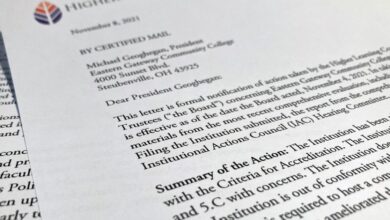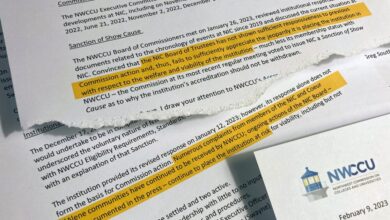A New Push to Make Financial-Aid Offers More Transparent

[ad_1]
So how much does this cost?
It’s a simple question people ask all time, whether they’re shopping for a winter coat or a Camry. But as many Americans know, it’s much more difficult to determine exactly how much money they’ll need to cover the costs of attending a particular college. For one thing, financial-aid offers are often downright confusing.
A new national initiative intends to change that. On Tuesday the leaders of 10 higher-education associations plan to announce the formation of a task force that aims to enhance the “clarity, accuracy, and consistency” of financial-aid offers, the main tool colleges use to communicate eligibility for federal, state, and institutional financial-aid programs to students. M. Peter McPherson, president emeritus of the Association of Public and Land-Grant Universities and chairman of the task force, told The Chronicle that its members plan to develop a set of standards and principles for colleges.
“This is a huge financial decision for families — they really need to understand what they’re getting into,” said McPherson, a former president of Michigan State University. “Millions of these aid offers go out every year. So it’s a big societal question whether the information is presented with clarity and accuracy, using words that people can understand.”
In recent years, McPherson has examined financial-aid offers his grandchildren received. “By and large, I thought they did a good job,” he said of those offers. “But in some cases, they weren’t as complete as they could be. Like, what’s the estimated full cost of attendance? And what’s included in that? I don’t think this is ever going to be perfect for every student, but we can have some common language, definitions, and expectations of what should be included in a way that can make things easier for students to make comparisons.”
This is a huge financial decision for families — they really need to understand what they’re getting into.
Concern about the lack of clarity in financial-aid offers is nothing new. More than a decade ago, the Obama administration released a model financial-aid offer that colleges could use to provide prospective students with standardized information on their true costs of attendance, as well as any grants, loans, and other financing options, such as Work-Study or military benefits.
But that initiative wasn’t a game-changer. And high-school counselors and college-access advocates continue to complain that the information institutions send to students is misleading and opaque at worst — and inconsistent at best.
That inconsistency is the result of colleges’ relying on homegrown systems to crank out financial-aid offers year after year. “Over time, colleges have developed their own language or parlance, and it’s often very focused on the way that administrators think about financial aid,” said Justin Draeger, president and chief executive of the National Association of Student Financial Aid Administrators, which is part of the initiative. “So what you have are aid offers that are all over the place.” As a result, it’s often difficult for students to get a clear sense of how much they must pay to attend a particular college, making it a challenge to compare the offers they receive.
Draeger described some typical concerns about aid offers. “One of the most common things we see is that they don’t contain the costs to the student or family. It’s ‘here’s how much financial aid you’re getting,’ but it’s devoid of the cost that they’ll be incurring. And that includes both billable direct expenses to the institution but also the nonbillable indirect expenses that schools use in constructing a cost of attendance for financial-aid purposes. Some families are just interested in how much they owe the school. Others will need financial aid to cover nonbillable expenses, like rent or transportation. Those costs are a really important piece of the financial-aid picture.”
Another common issue: colleges “mislabeling” student loans. “That might mean not labeling loans as actual loans,” Draeger said. “Other times, it’s combining loans and grants when, really, those two things ought to be separated. We’ve found examples of colleges that have lumped all their financial aid into sort of one bucket.”
Colleges aren’t trying to mislead students, Draeger said. But understaffing in financial-aid offices and the nonstop scramble to meet students’ needs while complying with federal regulations can leave a staff with little time or bandwidth to update its information system with consumer-friendly language, or to make sure its aid offers reflect the industry’s latest best practices.
Draeger’s association has long pushed for greater standardization in aid offers. It has tested various templates with students and families to determine which ones seem most clear and effective. And the association’s Code of Conduct identifies basic components that every aid offer should include.
The new initiative will expand on those efforts by bringing together college presidents, financial-aid leaders, and admissions officials. The task force’s members also include the American Council on Education, the American Association of Community Colleges, the National Association for College Admission Counseling, and the National Association of Independent Colleges and Universities.
That task force will be weighing questions about the precise wording of financial-aid offers. But Draeger sees something greater at stake.
“In higher education, we are struggling with a public-trust issue, and we’re seeing that in poll after poll,” he said. “If we want to be trusted partners to students and families in furthering our educational and economic pursuits, then we have to be completely open and transparent. And I think colleges want to be open and transparent. This is just one area where we haven’t really focused enough resources and attention.”
[ad_2]
Source link






